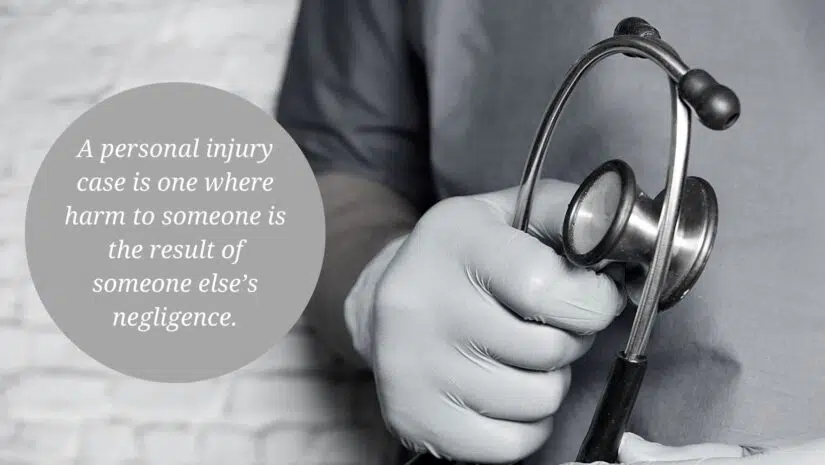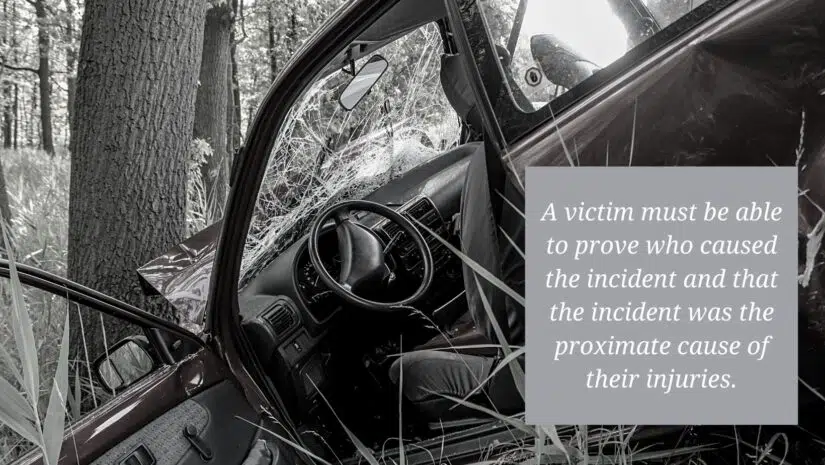What Kinds of Accidents are Considered “Personal Injury?”

There is an entire branch of the law devoted to “personal injury” cases. But what does that mean, exactly? After all, people get injured in all types of mishaps, but not every incident involves lawyers or financial settlements.
In short, a personal injury case is one where harm to someone is the result of someone else’s negligence. Most people think of car accidents when considering personal injury cases. But the term also covers things like slip and falls, dog bites, injuries due to defective products, and more.
These cases involve a victim who suffers a loss (medical expenses, lost wages, permanent disability, etc.) because of the actions (or lack thereof) of another individual or a business entity. The victim deserves compensation for their injuries. This means negotiating with insurance companies, and sometimes, taking people to court. Doing that alone is difficult, especially while recuperating after an accident. Instead, it is best to contact an experienced personal injury attorney for help.
What Does Personal Injury Mean?
Sometimes “personal injury” and “bodily injury” are used interchangeably. Both refer to physical damage, like broken bones, sprains, cuts, nerve damage, or head injuries. But personal injuries may also include “invisible” conditions that can last long after the cuts and bruises have healed. These are often harder to prove and link to an accident. Examples include chronic migraines after a concussion, insomnia, depression, anxiety, or PTSD after a particularly violent crash.
Personal injury cases may seek damages for all of these things. In addition, a claim may ask for damages due to harm that is more than just physical such as emotional distress, pain and suffering, and mental anguish.
Types of Personal Injury Cases
The personal injury cases that we see at Hipskind & McAninch typically fall into a few basic categories:
Car accidents
Slip and falls
Dog bites
Defective products
Medical malpractice
What all of these types of cases have in common is that someone was negligent or breached their duty of care. It does not matter if the person did not mean to hurt anyone and had no malicious intent. If the incident occurred because of the person’s actions, they can be liable for the victim’s injuries.
Personal injury cases are civil rather than criminal cases. Although, in some situations, there may be a criminal aspect to the case. For example, if an at-fault driver was drunk, they will face criminal charges brought by the state and owe the victim financial compensation.

Work-related accidents are not considered personal injury cases. Instead, they are subject to workman’s compensation claims, which are handled by workman’s comp lawyers.
Can You Prove Causation?
The fundamental element of any personal injury claim is causation. In other words, a victim must be able to prove who caused the incident and that the incident was the proximate cause of their injuries. “Proximate cause” means that there is a clear, unbroken chain of events leading to the injuries. A case will only be successful if proximate cause is proven, and the injuries would not have been suffered had the at-fault person (or business) not acted as they did.
Let’s say Driver A runs a stop sign and hits Driver B’s car, resulting in a broken leg for Driver B. The crash is the proximate cause of Driver B’s injury, and Driver A is to blame and therefore liable.
On the other hand, let’s say Driver A and Driver B are in a fender-bender where neither sustains injuries. As Driver B exits his car onto the shoulder, he slips on some mud and tumbles into a ravine, breaking his leg. While Driver A might have caused the accident, proving that the accident was the proximate cause of the broken leg would be more difficult.In some states, both parties may share in the blame for a personal injury under comparative negligence rules. Missouri is known as a pure comparative negligence state. This means that if the victim is partially responsible, their settlement will be reduced by an equal percentage.
(Meaning, if the victim is found to be 25% responsible, they would only collect 75% of the total damages.)
Illinois is a modified comparative negligence state. This works the same as in Missouri unless the victim is more than 50% responsible. In that case, they would receive nothing.
Consider our first example above. If, when Driver A ran the stop sign Driver B was making an illegal turn, both might share the blame.

Or, in the case of a slip and fall, a grocery store might be to blame for not mopping up a spill. But someone who ignores a “wet floor” sign or walks around a barricade might be found partially liable for their own injuries.
Proving a personal injury case can depend on police reports, witnesses, and photo or video evidence. An experienced personal injury attorney understands which pieces of evidence will help make a case and knows how to go about gathering proof.
What Damages Can Be Collected For Personal Injuries?
Personal injury claims may be made up of economic and non-economic compensatory damages. In rare cases, punitive damages might be added too.
Economic damages are fairly easy to calculate. They include reimbursements for actual bills from doctors, hospitals, pharmacies, physical therapists, and any other medical expenses incurred, as well as lost wages. A claim might consider future costs too, such as additional treatment that might be necessary for upcoming months or even years.
Non-economic damages are harder to estimate. A dollar amount is placed on things like pain and suffering, mental anguish, loss of enjoyment of life, or loss of companionship (in the event of a death).
Punitive damages are meant to punish a defendant when their actions are exceptionally heinous or malicious. It is very unusual for a typical personal injury case to include punitive damages.
Steps in a Personal Injury Case
If you are hurt in any type of accident that is not your fault, the first step is to contact an attorney such as Hipskind & McAninch. Even accidents that seem straightforward like a car crash, slip and fall, or dog bite, can be complicated and difficult to prove liability. An experienced attorney will discuss your case’s merit and walk you through the steps to get compensation.
Personal injury cases typically start with an insurance claim. It is important to remember that an insurance company will try to settle a claim as quickly and for as little as possible. Once a victim signs a document accepting a settlement, the case is over and there is no chance to go back for more money if there are additional medical expenses.
Dog Bite Lawyer Belleville are familiar with insurance company procedures and can negotiate for the best possible settlement. In fact, the majority of personal injury cases are settled out of court. If the parties can not reach an agreement, a personal injury lawyer will file a lawsuit on your behalf to fight for the fair and full settlement you deserve.
Category:
Personal Injury, Dog Bites, Slip And Fall Injuries
Tags:
dog bites, personal injury, slip and fall, slip and fall injuries